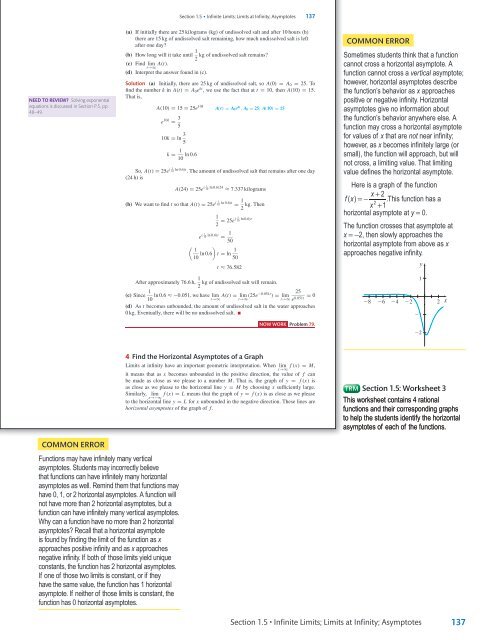Sullivan Microsite DigiSample
Create successful ePaper yourself
Turn your PDF publications into a flip-book with our unique Google optimized e-Paper software.
<strong>Sullivan</strong> AP˙<strong>Sullivan</strong>˙Chapter01 October 8, 2016 17:4<br />
Section 1.5 • Infinite Limits; Limits at Infinity; Asymptotes 137<br />
NEED TO REVIEW? Solving exponential<br />
equations is discussed in Section P.5, pp.<br />
48--49.<br />
(a) If initially there are 25 kilograms (kg) of undissolved salt and after 10 hours (h)<br />
there are 15 kg of undissolved salt remaining, how much undissolved salt is left<br />
after one day?<br />
(b) How long will it take until 1 kg of undissolved salt remains?<br />
2<br />
(c) Find lim A(t).<br />
t→∞<br />
(d) Interpret the answer found in (c).<br />
Solution (a) Initially, there are 25 kg of undissolved salt, so A(0) = A 0 = 25. To<br />
find the number k in A(t) = A 0 e kt , we use the fact that at t = 10, then A(10) = 15.<br />
That is,<br />
A(10) = 15 = 25e 10k A(t) = A 0e kt , A 0 = 25; A(10) = 15<br />
e 10k = 3 5<br />
10k = ln 3 5<br />
k = 1 ln 0.6<br />
10<br />
So, A(t) = 25e ( 1 10 ln 0.6)t . The amount of undissolved salt that remains after one day<br />
(24 h) is<br />
A(24) = 25e ( 1<br />
10 ln 0.6)24 ≈ 7.337 kilograms<br />
(b) We want to find t so that A(t) = 25e ( 1 10 ln 0.6)t = 1 kg. Then<br />
2<br />
1<br />
2 = 25e( 1<br />
e ( 1<br />
10 ln 0.6)t = 1 50<br />
( ) 1<br />
10 ln 0.6 t = ln 1<br />
50<br />
t ≈ 76.582<br />
10 ln 0.6)t<br />
common error<br />
Sometimes students think that a function<br />
cannot cross a horizontal asymptote. A<br />
function cannot cross a vertical asymptote;<br />
however, horizontal asymptotes describe<br />
the function’s behavior as x approaches<br />
positive or negative infinity. Horizontal<br />
asymptotes give no information about<br />
the function’s behavior anywhere else. A<br />
function may cross a horizontal asymptote<br />
for values of x that are not near infinity;<br />
however, as x becomes infinitely large (or<br />
small), the function will approach, but will<br />
not cross, a limiting value. That limiting<br />
value defines the horizontal asymptote.<br />
Here is a graph of the function<br />
x<br />
fx=− + 2<br />
( )<br />
x + 1 . This function has a<br />
2<br />
horizontal asymptote at y = 0.<br />
The function crosses that asymptote at<br />
x = −2, then slowly approaches the<br />
horizontal asymptote from above as x<br />
approaches negative infinity.<br />
y<br />
After approximately 76.6 h, 1 kg of undissolved salt will remain.<br />
2<br />
(c) Since 1<br />
25<br />
ln 0.6 ≈−0.051, we have lim A(t) = lim<br />
10 t→∞ t→∞ (25e−0.051t ) = lim = 0<br />
t→∞ e 0.051t<br />
(d) As t becomes unbounded, the amount of undissolved salt in the water approaches<br />
0 kg. Eventually, there will be no undissolved salt. ■<br />
1<br />
28<br />
26<br />
24<br />
22<br />
21<br />
2<br />
x<br />
NOW WORK Problem 79.<br />
22<br />
4 Find the Horizontal Asymptotes of a Graph<br />
Limits at infinity have an important geometric interpretation. When lim f (x) = M,<br />
x→∞<br />
it means that as x becomes unbounded in the positive direction, the value of f can<br />
be made as close as we please to a number M. That is, the graph of y = f (x) is<br />
as close as we please to the horizontal line y = M by choosing x sufficiently large.<br />
Similarly, lim f (x) = L means that the graph of y = f (x) is as close as we please<br />
x→−∞<br />
to the horizontal line y = L for x unbounded in the negative direction. These lines are<br />
horizontal asymptotes of the graph of f.<br />
TRM Section 1.5: Worksheet 3<br />
This worksheet contains 4 rational<br />
functions and their corresponding graphs<br />
to help the students identify the horizontal<br />
asymptotes of each of the functions.<br />
common error<br />
Functions may have infinitely many vertical<br />
asymptotes. Students may incorrectly believe<br />
that functions can have infinitely many horizontal<br />
asymptotes as well. Remind them that functions may<br />
have 0, 1, or 2 horizontal asymptotes. A function will<br />
not have more than 2 horizontal asymptotes, but a<br />
function can have infinitely many vertical asymptotes.<br />
Why can a function have no more than 2 horizontal<br />
asymptotes? Recall that a horizontal asymptote<br />
is found by finding the limit of the function as x<br />
approaches positive infinity and as x approaches<br />
negative infinity. If both of those limits yield unique<br />
constants, the function has 2 horizontal asymptotes.<br />
If one of those two limits is constant, or if they<br />
have the same value, the function has 1 horizontal<br />
asymptote. If neither of those limits is constant, the<br />
function has 0 horizontal asymptotes.<br />
Section 1.5 • Infinite Limits; Limits at Infinity; Asymptotes<br />
137<br />
TE_<strong>Sullivan</strong>_Chapter01_PART II.indd 20<br />
11/01/17 9:56 am




